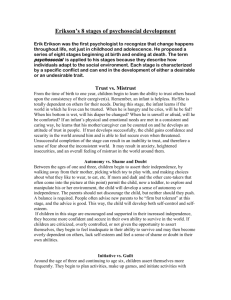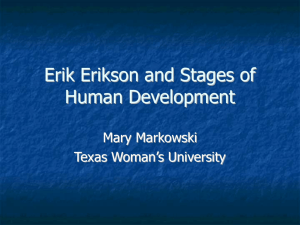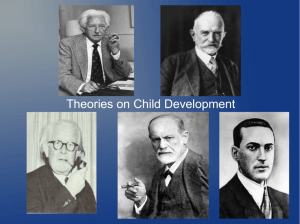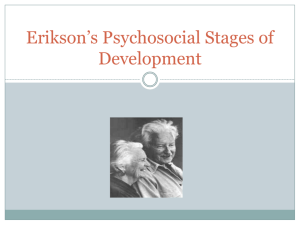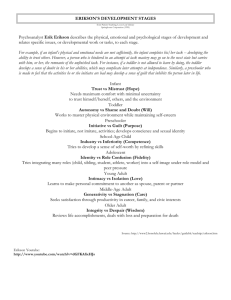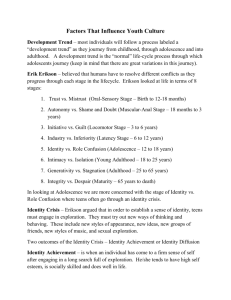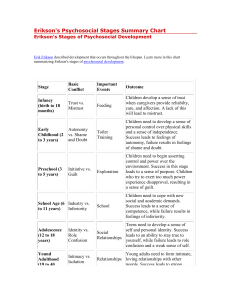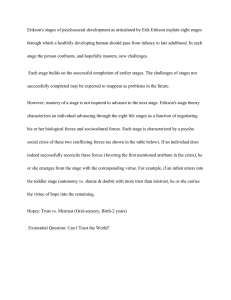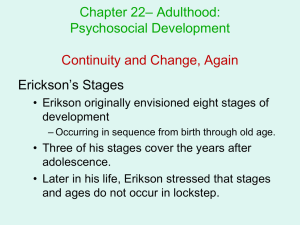ERIKSON'S THEORY
advertisement
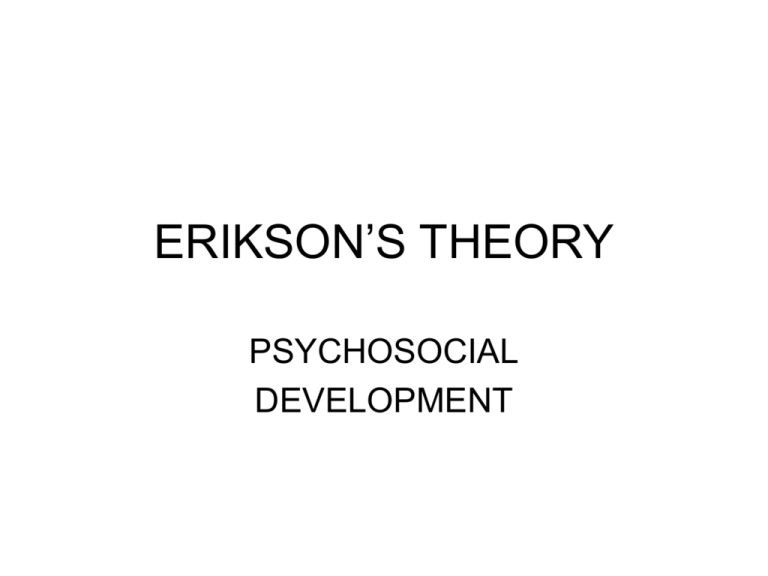
ERIKSON’S THEORY PSYCHOSOCIAL DEVELOPMENT Oral Sensory Age: Infancy -- Birth to 1 year Conflict: Trust vs. Mistrust Important Event: Feeding • Description: • The important event in this stage is feeding. According to Erikson, the infant will develop a sense of trust only if the parent or caregiver is responsive and consistent with the basic needs being meet. The need for care and food must be met with comforting regularity. The infant must first form a trusting relationship with the parent or caregiver, otherwise a sense of mistrust will develop. • Elements for a positive outcome: • The infant's need for care, familiarity, comfort and nourishment are met. Parental consistency and responsiveness is essential for the sense of trust to develop. • Elements for a negative outcome: • Babies who are not securely attached to their mothers are less cooperative and more aggressive in their interactions with their mothers. As they grow older, they become less competent and sympathetic with peers. They also explore their environment with less enthusiasm and persistence. • Examples: • Babies will begin to understand that objects and people exist even when they cannot see them. This is where trust becomes important. Muscular-Anal • • • • Age:Toddler period -- 1 to 2 years Conflict: Autonomy vs. Doubt Important Event: Toilet Training Description: According to Erikson, self control and self confidence begin to develop at this stage. Children can do more on their own. Toilet training is the most important event at this stage. They also begin to feed and dress themselves. This is how the toddler strives for autonomy. It is essential for parents not to be overprotective at this stage. A parent's level of protectiveness will influence the child's ability to achieve autonomy. If a parent is not reinforcing, the child will feel shameful and will learn to doubt his or her abilities. "Erikson believes that children who experience too much doubt at this stage will lack confidence in their powers later in life" Muscular-Anal • Elements for a positive outcome: • The child must take more responsibility for his or her own feeding, toileting, and dressing. Parents must be reassuring yet avoid overprotection. • Elements for a negative outcome: • If parents do not maintain a reassuring, confident attitude and do not reinforce the child's efforts to master basic motor and cognitive skills, children may begin to feel shame; they may learn to doubt their abilities to manage the world on their own terms. Children who experience too much doubt at this stage will lack confidence in their own powers throughout life. • Examples: • In this stage children begin to assume important responsibilities for self-care like feeding toileting, dressing. Locomotor stage • Age: Early Childhood -- 2 to 6 years Conflict: Initiative vs. Guilt • Important Event: Independence • Description: • The most important event at this stage is independence. The child continues to be assertive and to take the initiative. Playing and hero worshipping are an important form of initiative for children. Children in this stage are eager for responsibility. It is essential for adults to confirm that the child's initiative is accepted no matter how small it may be. If the child is not given a chance to be responsible and do things on their own, a sense of guilt may develop. The child will come to believe that what they want to do is always wrong. Locomotor • Elements for a positive outcome: • In order for a positive outcome in this stage, the child must learn toaccept without guilt, that there are certain things not allowed. Children mustbe guilt free when using imagination. They must be reassured that it is okay toplay certain adult roles. • Elements for a negative outcome: • If children are not allowed to do things on their own, a sense of guilt maydevelop and they may come to believe that what they want to do is always wrong. • Examples: • A four year old passing tools to a parent who is fixing a bicycle. Children at this stage will worship heroes. Pretend games are also common Latency • • • • • Age: Elementary and Middle School Years -- 6 to 12 years Conflict: Industry vs. Inferiority Important Event: School Description: "In this stage children are learning to see the relationship between perseverance and the pleasure of a job completed"(Woolfolk, 1987).The important event at this stage is attendance at school. As a student, the children have a need to be productive and do work on their own. They are both physically and mentally ready for it. Interaction with peers at school also plays an imperative role of child development in this stage. The child for the first time has a wide variety of events to deal with, including academics, group activities, and friends. Difficulty with any of these leads to a sense of inferiority. Latency • Elements for a positive outcome: • It is essential for the child at this stage to discover pleasure in being productive and the need to succeed. The child's relationship with peers in school and the neighborhood become increasingly important. • Elements for a negative outcome: • Difficulty with the child's ability to move between the world at home and the world of peers can lead to feeling of inferiority. Latency • Examples: • In this stage children want to do productive work on their own. Students are able to water class plants, collect and distribute materials for teacher, and keep records of forms for teacher. Adolescence • • • • • Age: Adolescence --12 to 18 years Conflict: Identity vs. Role Confusion Important Event: Peer relationships Description: At this stage, adolescents are in search of an identity that will lead them to adulthood. Adolescents make a strong effort to answer the question "Who am I?" Erikson notes the healthy resolution of earlier conflicts can now serve as a foundation for the search for an identity. If the child overcomes earlier conflicts they are prepared to search for identity. Did they develop the basic sense of trust? Do they have a strong sense of industry to believe in themselves? • Elements for a positive outcome: • The adolescent must make a conscious search for identity. This is built on the outcome and resolution to conflict in earlier stages. • Elements for a negative outcome: • If the adolescent can not make deliberate decisions and choices, especially about vocation, sexual orientation, and life in general, role confusion becomes a threat. • Examples: • Adolescents attempt to establish their own identities and see themselves as separate from their parents Young Adulthood • • Age: Young Adulthood -- 19 to 40 years Conflict: Intimacy vs. Isolation • • • Important Event: Love relationships Description: In this stage, the most important events are love relationships. Intimacy refers to one's ability to relate to another human being on a deep, personal level. An individual who has not developed a sense of identity usually will fear a committed relationship and may retreat into isolation. It is important to mention that having a sexual relationship does not indicate intimacy. People can be sexually intimate without being committed and open with another. True intimacy requires personal commitment. However, mutual satisfaction will increase the closeness of people in a true intimate relationship. • • Elements for a positive outcome: • The young adult must develop intimate relationships with others. Not resolving this conflict leaves the young adult feeling isolated. The young adult must be willing to be open and committed to another individual. • Elements for a negative outcome: • An individual may retreat into isolation if a sense of identity is not developed and will fear a committed relationship. • Examples: • Giving and sharing with an individual without asking what will be received in return. • • • • Age : Middle adulthood -- 40 to 65 years Conflict: Generativity vs. Stagnation Important Event: ParentingDescription: In this stage generativity refers to the adult's ability to care for another person. The most important event in this stage is parenting. Does the adult have the ability to care and guide the next generation? Generativity has a broader meaning then just having children. Each adult must have some way to satisfy and support the next generation. According to Erikson, "A person does best at this time to put aside thoughts of death and balance its certainty with the only happiness that is lasting: to increase, by whatever is yours to give, the goodwill and higher order in your sector of the world"(Erikson, 1974). • Elements for a positive outcome: • To have and nurture children and/or become involved with future generations. • Elements for a negative outcome: • An individual must deal with issues they are concerned with or it can lead to stagnation in later life. • Examples: • In this stage an adult will be concerned with issues such as: the future of the environment, what kind of world will we leave the next generation, equality for all people, etc. • Age: Late Adulthood -- 65 years to deathConflict: Integrity vs. DespairImportant Event: Reflection on and acceptance of one's lifeDescription: • The most important event at this stage is coming to accept one's whole life and reflecting on that life in a positive manner. According to Erikson, achieving a sense of integrity means fully accepting oneself and coming to terms with the death. Accepting responsibility for your life and being able to undo the past and achieve satisfaction with self is essential. The inability to do this results in a feeling of despair. • Elements for a positive outcome: • The adult feels a sense of fulfillment about life and accepts death as an unavoidable reality. • Elements for a negative outcome: • Individuals who are unable to obtain a feeling of fulfillment and completeness will despair and fear death. • Examples: • An aged person may find it necessary to reflect and analyze what they have accumulated throughout life and decide what offspring will receive from them upon death.
